Do you have a Great Dane? If so, you may have noticed that they love to sit on things. Sofas, chairs, laps – no surface is safe! But why do they do this?
It’s actually not as strange as it seems. In fact, there is a very good reason behind this funny habit. Keep reading to find out what it is!
Key Takeaway
- Great Danes often sit on things due to their affectionate nature, desire for comfort, protective behavior, and instinctual need to be close to their loved ones.
- Certain bodily-related conditions such as hip dysplasia, arthritis, or other joint issues may cause your Great Dane to sit on things as a way to seek comfort or relieve pain.
6 Reasons Why Great Danes Like To Sit On Things
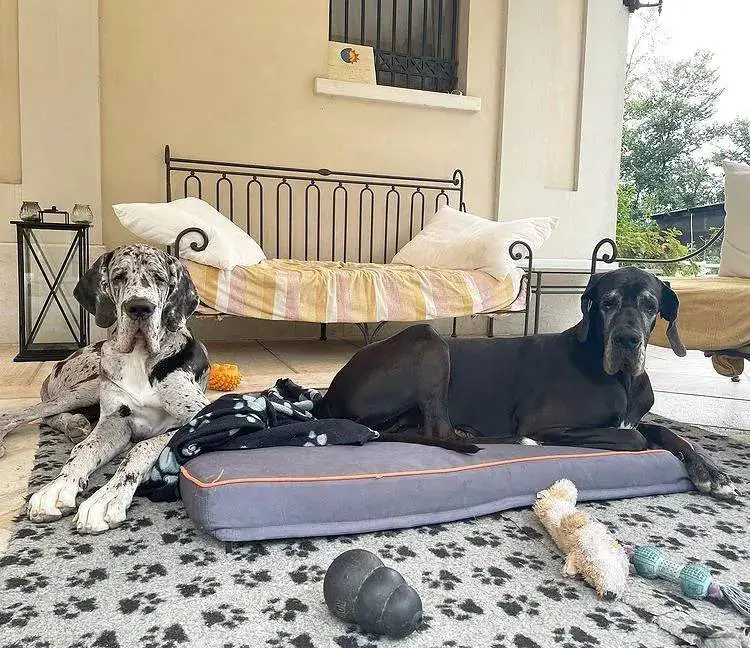
Great Danes like to sit on things due to a variety of reasons ranging from showing affection and loyalty to seeking comfort and expressing protective behavior.
1. Great Danes think they deserve it
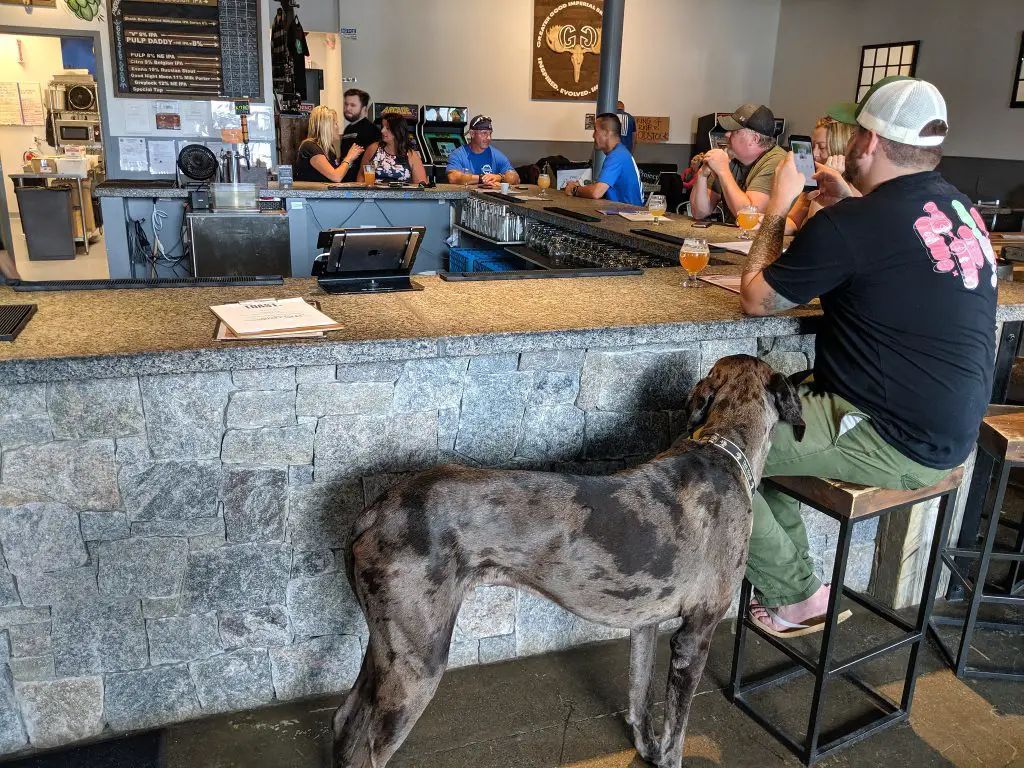
First, great Danes believe they are still puppies and lapdogs. Most puppies prefer to sit on their loved one’s lap, always leaning in for a closer look. As a result, Great Danes believe they are puppies and are unaware of their size!
They can sit anywhere and on anything where you sit. It could be your bed, couch, chair, or even the seats in your car! Unfortunately, they are unaware of how taller and more prominent they are and lean on you, squeezing you.
2. Affection
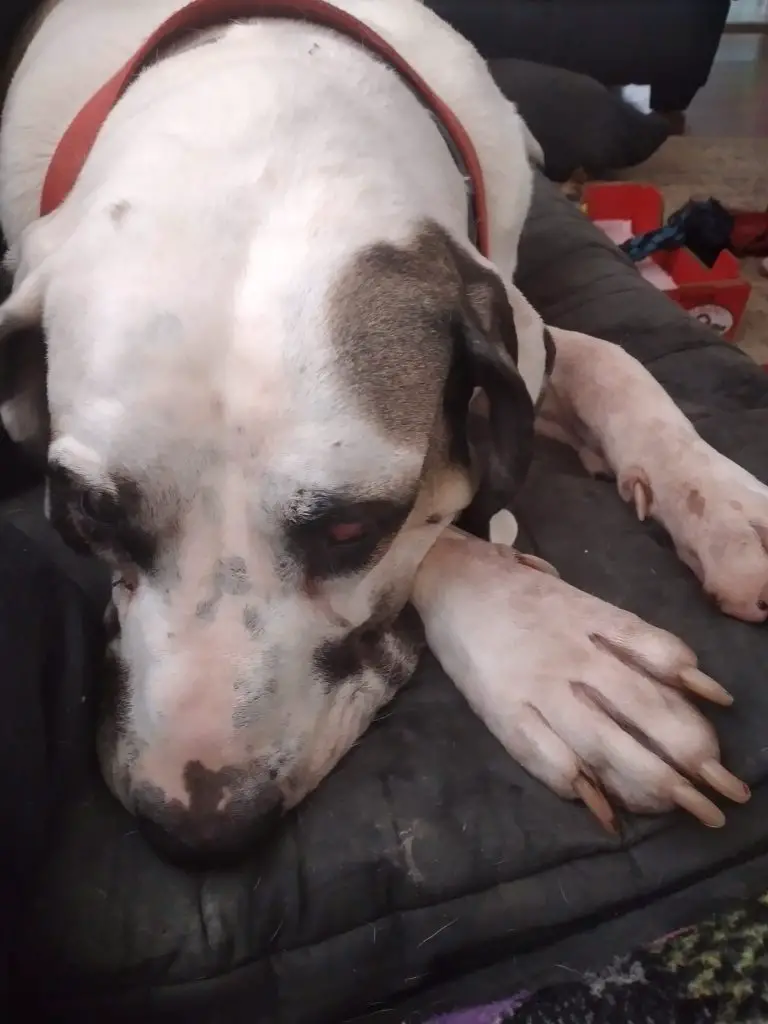
This breed is known for needing attention, and these dogs adore their owners. They enjoy showing their affection for you by constantly cuddling, leaning, and sitting with you.
There is no doubt that they are dogs with big hearts and are extremely sensitive, which is why they are so loving. They prefer to be near their trusted faces because it makes them feel loved, precious, and more connected to you.
3. Seeking solace
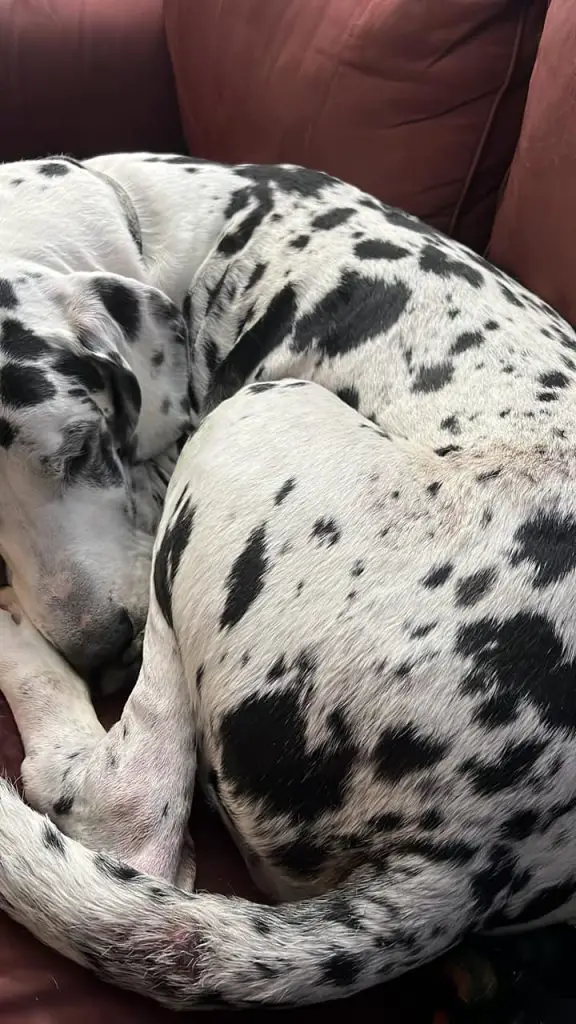
While it might seem like your Great Dane is trying to take over the world when they sit on your feet, it’s more likely that they’re just seeking comfort. Dogs are social creatures who crave physical contact, and sitting on their owner’s feet fulfills this need. Additionally, dogs often sit on their owner’s feet as a way of showing submissiveness and respect.
4. An indication that they missed you
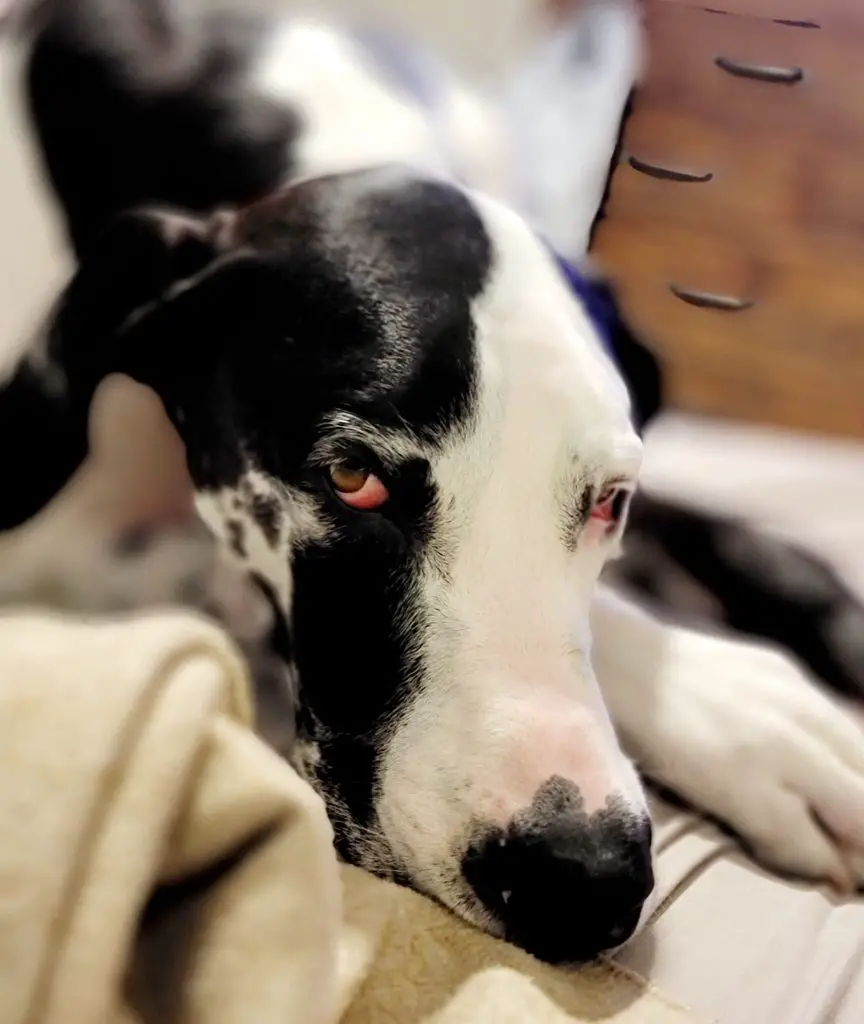
Because they are always affectionate, these pets miss you more than you can imagine! So, if you are away from your Great Danes for an extended period, they will spend more time with you when you return home.
5. To warm up
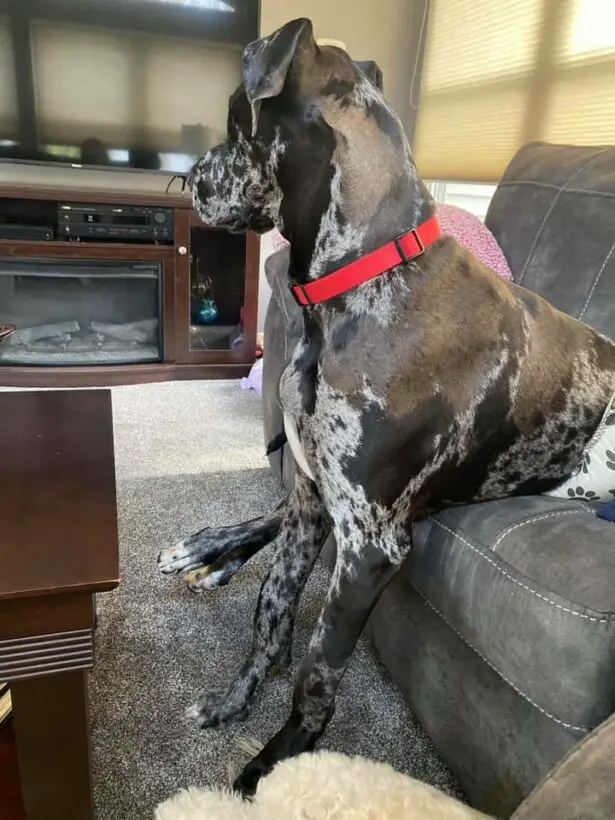
Great Danes have short coats and low body fat, which aids in keeping them warm. On the other hand, Great Danes tend to be cold if you live in a cold climate. As a result, they prefer to cuddle to stay warm. As a result, it is always best to cover them with blankets to keep them warm.
6. To keep you safe
Another reason Great Danes sit on everything or stick close to you is that they are protective. They try to get closer to you and be around you all the time so they can bark at anyone who irritates you. Isn’t this the cutest thing? These pets have a possessive instinct towards their pet parents.
3 Bodily Related Conditions That May Make Your Great Dane Sit On Things

There are a few bodily-related issues that could be causing your Great Dane to sit on things.
1. Hip Dysplasia
Great Danes are especially vulnerable to hip dysplasia due to their large size. This debilitating condition can cause a great deal of pain and suffering for the dog, and often leads to an early death. Fortunately, there are steps that can be taken to help prevent hip dysplasia in Great Danes.
Hip dysplasia affects the majority of Great Danes. If you purchased your Great Danes from a well-known breeder, they most likely took care of preventing this disease in your dog. However, it is still possible. Consult a veterinarian if your Great Danes lean or sit in an awkward position.
One of the most important things you can do is to make sure your Great Dane gets plenty of exercise. This will help keep their joints healthy and strong, and will also help maintain their weight at a healthy level.
Keeping your Great Dane at a healthy weight is crucial, as obesity can dramatically increase the risk of developing hip dysplasia says Great Dane Care.
2. Anxiety
Because Great Danes crave your attention, they may panic if they don’t see you for several hours. Then, just like humans, they become stressed and may not eat or chew food properly.
Many people don’t realize that Great Danes are prone to anxiety. This is because they are such a large breed of dog. But, just like any other dog, they can get anxious about things like loud noises, new environments, and being left alone.
Spending more time with them is the best way to cheer them up if they become anxious. Try playing games and doing simple activities. This can instantly lift their spirits and make them happy.
Anxiety in Great Danes can manifest itself in different ways. Some dogs may pace back and forth, some like to sit on things, and others may pant excessively or try to hide. Some may even become aggressive.
If you think your Great Dane is suffering from anxiety, it’s important to talk to your veterinarian. They can help you come up with a plan to help your dog feel more comfortable and relaxed.
3. Maturity
Great Danes mature into more prominent and taller dogs over time. When fully grown, these dogs prefer to have your undivided attention. They still feel like puppies, but they use their larger bodies. They can be more emotional than other dogs and, as a result, constantly seek your attention.
Other Reasons Why Great Danes Sit on Everything
Great Danes are prone to several physical ailments that cause them to sit anywhere. Other than cuddling, squeezing, and leaning more onto you and every other object in your home, Great Danes may exhibit this behavior for various reasons—some of the most serious of which may be health issues.
I’m just curious why sitting on couches seems to be a trait shared by all Danes. I think it’s adorable, but I can see why so many people don’t. When they start doing the Dane sit in bed, it’s the best part! Vincent (my Great Dane) sat on my head a couple of nights ago while sleeping on my side! It wasn’t amusing at the time, but I can laugh about it now.
A good reason why your Great Dane may want to sit or lean on you or objects around the house is because of a more serious underlying cause. Great Danes, for example, are prone to hip dysplasia.
Granted, if you purchased your Great Dane from a reputable breeder, this breeder has most likely done the necessary research to ensure that all of his Great Dane puppies are not at risk for this disease. But it is still possible.
Keep track of how often and in what positions your Great Dane sits or leans. If he appears to want to bend more than usual or depends in an unusual position compared to his normal leaning behavior, it is probably time to take him to the vet.
Because of their massive size, Great Danes require more vet visits than other breeds. If you notice this behavior, you should take your pet to the vet for a check-up.
How To Discourage a Great Dane From Sitting On Things
To discourage a Great Dane from sitting on things, it’s important to establish boundaries, provide alternative comfortable spaces, and reinforce positive behavior.
1. Establish Boundaries
Establishing boundaries is crucial in discouraging your Great Dane from sitting on things. This means teaching them which surfaces or areas are off-limits. As a vet, I often recommend starting this training early, when the dog is still a puppy. Use firm but gentle commands to signify what they can and cannot sit on.
2. Provide Alternative Comfortable Spaces
Great Danes sit on things primarily for comfort. Therefore, providing alternative comfortable spaces can encourage them to use those instead. Consider investing in large, soft dog beds or mats that your Great Dane will enjoy. In my experience, once they find their own cozy spot, they’re less likely to invade yours.
3. Positive Reinforcement
Positive reinforcement is an effective method to discourage unwanted behavior. Reward your Great Dane when they choose to sit on their own bed or designated spot instead of other places. This could be with treats, praise or extra petting. I’ve found that dogs respond well to this approach, learning quickly what actions earn them rewards.
4. Consistent Training
Consistency is key when training your Great Dane not to sit on certain things. If you allow them to sit on the couch one day and then scold them for it the next, it sends mixed signals. Consistent training helps them understand and remember the rules.
5. Distract and Divert Attention
If you notice your Great Dane about to sit on something they shouldn’t, distract them and divert their attention. A toy or a command can be useful in these situations. Over time, this strategy can help reduce the undesired sitting behavior.
6. Seek Professional Help If Needed
Lastly, if you’re struggling to discourage your Great Dane from sitting on things despite your best efforts, consider seeking professional help. A dog trainer or behaviorist can provide personalized strategies and techniques based on your dog’s specific needs. In my veterinary practice, I’ve seen many dog owners benefit from this kind of professional guidance.
FAQs
Q: Is sitting on things a common behavior in Great Danes?
A: Yes, sitting on things is a common behavior in Great Danes. Many Great Danes enjoy finding comfortable spots to sit or lay on, whether it’s a couch, a chair, or even your lap.
Q: Is sitting on things a sign of dominance in Great Danes?
A: No, sitting on things is not necessarily a sign of dominance in Great Danes. It’s more of a comfort-seeking behavior and a way for them to be closer to their owners.
Q: Are there any health concerns associated with Great Danes sitting on things?
A: For the most part, there are no specific health concerns associated with Great Danes sitting on things. However, it’s important to ensure that the furniture they are sitting on is clean and not filled with allergens or harmful substances.
Q: Can sitting on things cause joint problems in Great Danes?
A: Sitting on things itself does not typically cause joint problems in Great Danes. However, if they consistently jump on and off furniture, it can put unnecessary strain on their joints. It’s best to provide them with ramps or stairs to access higher spots if needed.
Q: Can sitting on things be a sign of anxiety in Great Danes?
A: In some cases, yes, sitting on things can be a sign of anxiety in Great Danes. If they are constantly seeking higher ground or displaying other signs of anxiety, it’s important to address the underlying cause and consult with a professional if necessary.
Q: Are there any benefits to allowing Great Danes to sit on things?
A: Allowing Great Danes to sit on things can provide them with a sense of comfort and security. It can also strengthen the bond between the dog and their owner as they are able to be close and share space.
Q: How can I make sitting on things more comfortable for my Great Dane?
A: To make sitting on things more comfortable for your Great Dane, you can provide them with soft cushions, blankets, or special dog furniture designed for their size and breed. This will help support their body and reduce the risk of discomfort.
Q: Does the age of the Great Dane affect their desire to sit on things?
A: The age of the Great Dane can sometimes affect their desire to sit on things. Younger dogs may have more energy and be more likely to jump on furniture, while older dogs may prefer a more comfortable and lower spot to rest.
Conclusion and final thoughts
Great Danes are known for their love of sitting on things, whether it’s a couch, a chair, or even their owner’s lap. In this blog post, we explored the reasons behind this odd behavior.
From their history as working dogs to their genetic predisposition to sitting on elevated surfaces, there are many possible explanations for why Great Danes like to sit on things.




